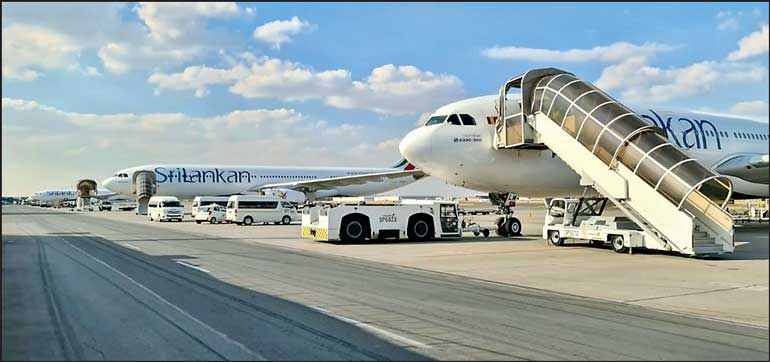Wednesday Jan 07, 2026
Wednesday Jan 07, 2026
Monday, 12 July 2021 00:00 - - {{hitsCtrl.values.hits}}

These are extraordinary times and the Government should make every effort to keep SriLankan Airlines flying – for it can be an important foreign exchange earner and tourism stimulator if utilised correctly
By a Special Correspondent
The Chairman of Committee on Public Enterprise (COPE), Prof. Charitha Herath, made an interesting remark at the meeting with SriLankan Airlines on 6 July – raising the question ‘… whether a country like Sri Lanka, under the COVID situation, can afford to have a national carrier’.
This is a question that has been asked many times over the recent years.
SriLankan Airlines has not made a profit since 2008 – when it last recorded a profit, while under the part-ownership and management of Emirates Airlines (EK). In fact, contrary to popular wisdom, the airline last recorded a genuine profit in 2006 – the profits in subsequent years of EK’s management having been made from sale of assets (See https://www.ft.lk/shippingaviation/Why-is-SriLankan-losing-money--An-analysis/21-643665).
Airlines worldwide have gone through the most turbulent period in history with the COVID-19 pandemic with almost all airlines recording massive losses. Even the most efficient companies in the region, such as Emirates Airlines who lost over $ 6.0 billion in the 2020/21 financial year and Singapore Airlines (losses of $ 3.2 billion) have faced dramatic reversals of fortune. Based on COPE discussions at COPE, it appears SriLankan lost a little over $ 200 million in this period.
One of the primary reasons, other than national pride, why states fund their flag carriers, is that an airline brings wider economic benefits to a country – inbound travel is stimulated, foreign currency inflows are enhanced, and jobs are created. The effects extend beyond the airline’s profit and loss statement. In a tacit acceptance of this reality, countries worldwide have come forward to the rescue of airlines – granting funding lifelines to even privately held airlines. The total state support given to airlines since 2020 now exceed $ 200 billion globally – ranging from US, Europe to Asia, to Africa and Latin America.
It is clear that running an airline is expensive business – and whether a country riled with economic distress as Sri Lanka can support one, is a serious question.
Can Sri Lanka afford to close down SriLankan?
That is a very different question. As revealed at COPE, SriLankan’s debt obligations today exceed over $ 900 million. The bulk of these appear to be debts to state banks and the Ceylon Petroleum Corporation, both wholly owned by the Government of Sri Lanka (GOSL). The airline also has at least one, sovereign guaranteed, internationally issued bond – worth $ 175 million.
Sri Lanka currently has no bankruptcy protection act, and the only option for a closedown would be a complete liquidation. If the Government is to shut down the airline – it will be compelled to write-off this debt to the state banks and the Petroleum Corporation. This could raise significant concerns of the two state banks’ liquidity by foreign rating agencies and could seriously jeopardise the prospects of Sri Lanka’s entire banking sector. The Government – as the guarantor – would also be called upon for an immediate repayment of the international bond worth
$ 175 million.
These blows might prove to be intolerable to Sri Lanka’s economy, given the perilous state that it is in right now.
Adding insult to the injury could be the many claims that SriLankan Airlines and GOSL will face in multiple jurisdictions, over non-payment of aircraft rentals. This will, eventually, increase the risk premium for airlines based in Sri Lanka to lease aircraft – and will make the country unattractive as a base for an airline. One party however may heave a sigh of relief – Airbus, which currently is facing a $ 1 billion claim from the airline over the tarnished A330 and A350 deals in 2013.
Wider implications of currency crises
Sri Lanka is on the brink of a major foreign currency crisis, with proven reserves of less than $ 4 billion. Historically, airlines tend to be risk-averse and are reluctant to operate out of markets that are going through a currency crisis. Tourism will be one of Sri Lanka’s key revenue streams to boost foreign currency inflows, provide employment and revive the economy. A mass pull-out of foreign airlines, without a national carrier to guarantee connectivity, will jeopardise any tourism centric economic recovery plans – and could drive economy into further peril.
In this context, despite all the historical losses, it would appear letting the national carrier wither away would be a mistake. These are extraordinary times and the Government of Sri Lanka should make every effort to keep SriLankan Airlines flying – for it can be an important foreign exchange earner, and tourism stimulator, if utilised correctly. Doing so may, in fact, save the country from greater economic damage and the despair associated with losing connectivity.
But will the airline continue to bleed and cost the GOSL more in coming years? How can the country support an inefficient and unprofitable enterprise without exposing itself to an even greater financial burden? We will discuss specific solutions in the second part of this article.